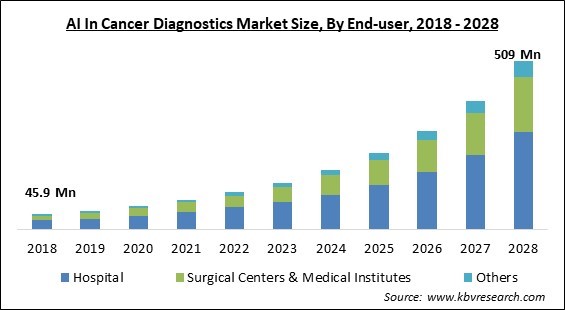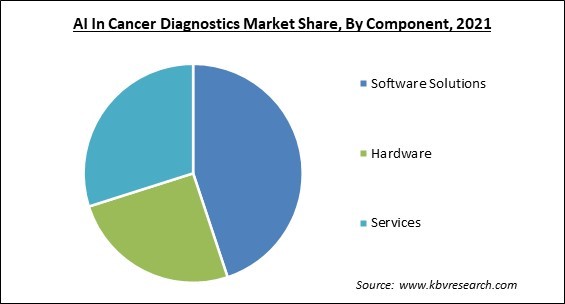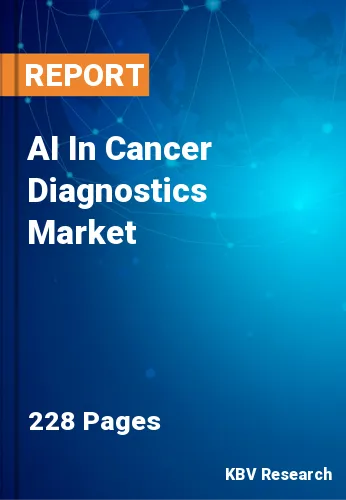The Global AI In Cancer Diagnostics Market size is expected to reach $509 million by 2028, rising at a market growth of 28.6% CAGR during the forecast period.
Artificial intelligence is an algorithm or computer program that utilizes data or information to make predictions and conclusions. To develop an algorithm, developers have created a bunch of rules or guidelines for the computer to follow the rules and commands. For an instant, Dr. Turkbey along with his team leveraged the current rules about prostate cancer that showed up on the MRI scan machine.

With the help of the machine crew utilized thousands of MRI research in their algorithm, which concluded many people has prostate cancer whereas many of them didn’t have any signs of cancer. The algorithm enrolls in how to evaluate and understand data while utilizing machine learning or artificial intelligence. Machine learning may utilize data that are not visible to the human brain or eyes.
Moreover, these algorithms keep on updating and being informed as they are exposed to new data. Deep learning along with machine learning and AI in the detection of cancer. It also utilizes Artificial neural networks which replicate how the human brain collects, analyzes, and reacts to the signals from the entire body. Researchers in NCI's intramural research program is utilizing the complete abilities of AI to enhance cancer testing in prostate and cervical cancer.
15 years ago, NCI physicians started executing biopsies backed by Magnetic resonance imaging, allowing researchers to target the areas of the prostate which could be cancerous. MRI biopsy enhanced the detection and treatment performed by prostate cancer professionals. Moreover, AI helps clinicians to record their diagnostic skills as well as makes algorithms available for clinics across the nation to assist with clinical diagnostics and decision-making.
The coronavirus had a positive impact on AI in the cancer diagnostic market. The implementation of the AI and machine learning assisted to reduce the workload of the health care and clinical facilities. With the growth of the industry, many international IT juggernauts have stepped with to develop AI tools and software to identify the coronavirus which would later help in detecting cancer symptoms. The shortage of healthcare professionals due to the coronavirus cases drives the adoption of AI solutions for better patient assistance and results. The diagnosis, aftercare, and other procedure were hard to maintain during the pandemic as they were time-consuming.
The technologies and the adoption of artificial intelligence in the detection of cancer diagnostics propel the growth of the healthcare sector. The artificial tools contain the need for low-price diagnostic procedures and quick detection data generation. The demand for technology developments in the healthcare sector for detecting and screening cancer is also anticipated to support industry growth. Moreover, the technological enhancement in healthcare by government spending drives the growth of the health care sectors in emerging nations.
The growing awareness of early cancer diagnostics drives the growth of AI in cancer diagnostics. The rise in the number of government programs to promote healthcare organizations along with healthcare providers to combine AI technologies in their hospitals for the betterment and advance the therapy of the patients. Moreover, the adoption of the technologies helps private organizations and nonprofit organizations to deliver enhanced medical results and the reduced cost of treatment which increases early diagnostic among people.
Managing huge datasets and databases along with the knowledge & training of AI systems and machine learning is the biggest barrier to deep learning technologies. However, the utilization of AI can also bring the issue of data breaches because it could provide crucial individual data such as genomic sequences. The various issues restricting the growth include the lack of transparency, risk of bias for the AI algorithms, data utilized for training purposes, and problem encounters while AI implementation authority in clinical settings. Philosophical issues are one of the thorniest problems faced in artificial intelligence.
By End-user, the AI in Cancer Diagnostics Market is classified into Hospital, Surgical Centers and Medical Institutes, and Others. The surgical centers & medical institutes segment registered a remarkable revenue share in the AI in cancer diagnostics market in 2021. It is because the adoption of AI has reduced the cases of misleading negatives and positives to deliver enhanced patient results. The evolution of medical education is propelling along with the growth of healthcare. Moreover, the adoption and practice of medicine with the implementation of AI and the utilization of data learning for better invention enhance the growth and decision making in the industry.

Based on the Component, the AI in Cancer Diagnostics Market is segmented into Software Solutions Hardware, and Services. The software solutions segment acquired the highest revenue share in the AI in cancer diagnostics market in 2021. It is because many big competitors are launching new solutions for the diagnosis of cancer. With the help of the software, doctors can efficiently and precisely identify the micro size of cancer or tumor. Moreover, artificial intelligence software is more precise and trustworthy than the human diagnostic system. The software platform provides high-quality analytics, and quick results grow the confidence of the doctors as well as boost productivity along with human safety.
On the basis of Cancer Type, the AI in Cancer Diagnostics Market is divided into Breast Cancer, Lung Cancer, Prostate & Colorectal Cancer, Brain Tumor, Skin Cancer & Cervical Cancer and Others. The breast cancer segment procured the largest revenue share in the AI in cancer diagnostics market in 2021. It is because the incidence of breast cancer is growing due to the cells in the breast growing out of control. Breast cancer depends on which cell is infected in the breast which came out as cancer. The breast is made up of three components which include ducts, lobules, and connective tissue.
| Report Attribute | Details |
|---|---|
| Market size value in 2021 | USD 90.4 Million |
| Market size forecast in 2028 | USD 509 Million |
| Base Year | 2021 |
| Historical Period | 2018 to 2020 |
| Forecast Period | 2022 to 2028 |
| Revenue Growth Rate | CAGR of 28.6% from 2022 to 2028 |
| Number of Pages | 228 |
| Number of Tables | 383 |
| Report coverage | Market Trends, Revenue Estimation and Forecast, Segmentation Analysis, Regional and Country Breakdown, Competitive Landscape, Companies Strategic Developments, Company Profiling |
| Segments covered | Component, Cancer Type, End-user, Region |
| Country scope | US, Canada, Mexico, Germany, UK, France, Russia, Spain, Italy, China, Japan, India, South Korea, Singapore, Malaysia, Brazil, Argentina, UAE, Saudi Arabia, South Africa, Nigeria |
| Growth Drivers |
|
| Restraints |
|
Region-wise, the AI in Cancer Diagnostics Market is analyzed across North America, Europe, Asia Pacific, and LAMEA. The North America segment acquired the largest revenue share in the AI in cancer diagnostics market in 2021. The growing cancer prevalence along with the accessibility of the updated healthcare infrastructure propel the growth of the market. However, the increasing government initiatives and the expenditure in the healthcare sector drive the growth of AI in the medical sector. The growing number of patient’s diagnostic propels the growth of AI in cancer diagnostics in this region.
Free Valuable Insights: Global AI In Cancer Diagnostics Market size to reach USD 509 Million by 2028

The major strategies followed by the market participants are Partnerships. Based on the Analysis presented in the Cardinal matrix; Microsoft Corporation is the forerunner in the AI In Cancer Diagnostics Market. Companies such as Flatiron Health (F. Hoffmann-La Roche Ltd.), Paige AI, Inc., PathAI, Inc. are some of the key innovators in AI In Cancer Diagnostics Market.
The market research report covers the analysis of key stake holders of the market. Key companies profiled in the report include Microsoft Corporation, Flatiron Health, Paige AI, Inc., PathAI, Inc., Therapixel, Tempus, Inc., SkinVision BV, Cancer Center Sp. z o.o., Medial EarlySign and Kheiron Medical Technologies Limited.
By End-user
By Component
By Cancer Type
By Geography
The global AI In Cancer Diagnostics Market size is expected to reach $509 million by 2028.
Increasing technological advancements in the healthcare sector are driving the market in coming years, however, Lack of Understanding of AI Use in the Healthcare Sector restraints the growth of the market.
Microsoft Corporation, Flatiron Health, Paige AI, Inc., PathAI, Inc., Therapixel, Tempus, Inc., SkinVision BV, Cancer Center Sp. z o.o., Medial EarlySign and Kheiron Medical Technologies Limited.
The Hospital market is leading the Global AI In Cancer Diagnostics Market by End-user in 2021; thereby, achieving a market value of $295.6 million by 2028.
The North America market dominated the Global AI In Cancer Diagnostics Market by Region in 2021; thereby, achieving a market value of $203.3 Million by 2028.
Our team of dedicated experts can provide you with attractive expansion opportunities for your business.

